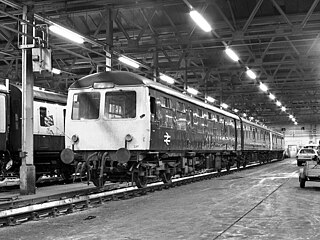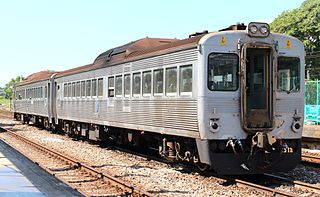
A diesel multiple unit or DMU is a multiple-unit train powered by on-board diesel engines. A DMU requires no separate locomotive, as the engines are incorporated into one or more of the carriages. Diesel-powered single-unit railcars are also generally classed as DMUs. Diesel-powered units may be further classified by their transmission type: diesel–mechanical DMMU, diesel–hydraulic DHMU, or diesel–electric DEMU.

A locomotive or engine is a rail transport vehicle that provides the motive power for a train. If a locomotive is capable of carrying a payload, it is usually rather referred to as a multiple unit, motor coach, railcar or power car; the use of these self-propelled vehicles is increasingly common for passenger trains, but rare for freight trains.

The British Rail Class 104 diesel multiple units were built by Birmingham Railway Carriage and Wagon Company from 1957 to 1959.

Sentinel Waggon Works Ltd was a British company based in Shrewsbury, Shropshire that made steam-powered lorries, railway locomotives, and later, diesel engined lorries, buses and locomotives.

The British Rail Classes 105 and 106 diesel multiple units were built by Cravens Ltd. of Sheffield from 1956 to 1959. The class were built with a side profile identical to British Railways Mark 1 carriage stock, using the same doors and windows. None were selected for refurbishment. The last passenger car was withdrawn from service in 1988.

Japan Transport Engineering Company (J-TREC) is a manufacturer of heavy rail cars in Japan, formerly known as Tokyu Car Corporation. The company is based in Kanazawa-ku, Yokohama, and a member of East Japan Railway Company group. J-TREC manufactures rail vehicles not only for JR East and Tokyu Corporation but for other Japanese operators, including various Japan Railways Group companies and international operators as well.

The Kawasaki Railcar Manufacturing Company is the Japanese rolling stock manufacturing subsidiary of Kawasaki Heavy Industries. Since beginning operations in 1906, the company has produced more than 90,000 railroad cars.

Nippon Sharyo, Ltd. , formed in 1896, is a major rolling stock manufacturer based in Nagoya, Japan. In 1996, it abbreviated its name to "日本車両" Nippon Sharyō. Its shortest abbreviation is Nissha "日車". It was a listed company on Nikkei 225 until 2004. It is listed on the Tokyo Stock Exchange and Nagoya Stock Exchange as ticker 7102. In 2008, Central Japan Railway Company became the majority shareholder (50.1%) of the financially struggling Nippon Sharyo making the firm a "consolidated subsidiary" of JR Central. In July 2012 Nippon Sharyo USA started production in their new facility in Rochelle, Illinois. The facility closed at the end of October 2018 due to a lack of orders.
Tze-Chiang, also Tzu-chiang or Ziqiang, is a type of limited express train service operated by Taiwan Railway (TR). Of the five service classes operated by TR, the Tze-Chiang service is the fastest. Ticketing is done on the basis of mileage.

The 900/800 class railcars were diesel multiple units built by the New South Wales Government Railways between November 1951 and November 1960.

The SCMaglev and Railway Park is a railway museum owned by Central Japan Railway Company in Nagoya, Japan. The museum opened on 14 March 2011.

The Class C12 is a type of 2-6-2T steam locomotive built by the Japanese Government Railways and the Japanese National Railways from 1932 to 1947. A total of 282 Class C12 locomotives were built and designed by Hideo Shima.

The DR2700 series, also locally affectionately known as the "White Steel Train", was a series of diesel multiple unit trains used by the Taiwan Railways Administration. They were originally built by Tokyu Car Corporation of Japan in 1966, in response to an order by the Taiwan Railways Administration, because of the need to renew the rolling stock on the by then 10-year-old Flying Formosan Express service.

The Nippon Sharyo DMU is a model of diesel multiple unit passenger train designed and manufactured by Nippon Sharyo for the North American market, and compliant with FRA Tier 1 crashworthiness standards. It has been ordered by Sonoma–Marin Area Rail Transit (SMART) in Sonoma and Marin Counties, California, and by Metrolinx for the Union Pearson Express airport link in Toronto, Ontario.

Taiwan Rolling Stock Company (TRSC) is a rail vehicle company. TRSC is located in Hukou, Hsinchu County, near Xinfeng railway station. It was previously a rolling stock production division of Tang Eng Iron Works before 2002. After privatization, the company received several orders from Taiwan Railways Administration and also Kawasaki Heavy Industries. For example, some vehicles of the Taipei Metro system were built by TRSC.

Tsuyama Railroad Educational Museum is a railway museum in Tsuyama, Okayama, Japan, operated by West Japan Railway Company since 2 April 2016. It is based around the former Tsuyama Depot roundhouse, which was used to house a number of preserved locomotives since 2007.
The Nakeha class railcars were a group of 3rd class narrow-gauge petrol-powered railcars of the Chosen Government Railway (Sentetsu). There were two classes of such railcars, one built in Japan and one built in Korea. After Liberation, they all remained in the South, where they were operated by the Korean National Railroad; none were preserved.

The Keha class railcars were a group of 3rd class petrol-powered railcars of the Chosen Government Railway (Sentetsu). There were five types of such railcars, built in Japan and Korea. The exact classification and numbering of these railcars is not certain; certain is only that their type designation was Keha. After the end of the war they were inherited by the Korean State Railway in North Korea and by the Korean National Railroad in South Korea.
The Jiha class railcars were a pair of Diesel-powered railcars of the Chosen Government Railway (Sentetsu). After Liberation, they all remained in the South, where they were operated by the Korean National Railroad; none were preserved.

The KiHa 35 series (キハ35), along with the similar KiHa 30 and KiHa 36 series, are Japanese diesel multiple unit (DMU) train types formerly operated by the Japanese National Railways (JNR) and JR Group of companies, and later operated by the private railway operators Kanto Railway and Mizushima Rinkai Railway. They were built from 1961 until 1966, and were widely used around Japan. Most units were withdrawn in 2012 with the exception of those used by private railways, which remained in service. Some were later operated by Philippine National Railways on Bicol Commuter Train since 2015, and on Metro South Commuter services since 2017.

















